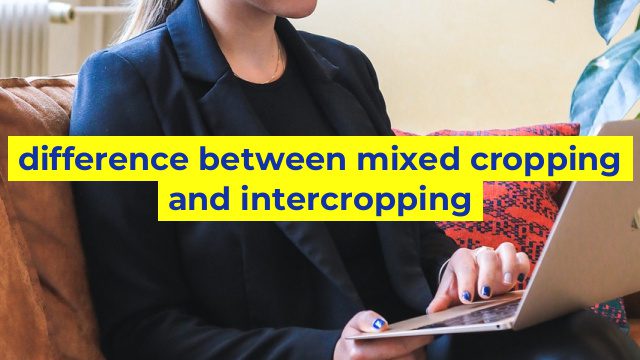Understanding the Difference Between Mixed Cropping and Intercropping
Agriculture has indeed evolved through the years, and one of the significant changes is the adoption of different types of farming. Mixed cropping and intercropping are two farming systems that have emerged as popular alternatives to conventional farming. But what exactly is the difference between mixed cropping and intercropping, and which farming system is better suited for your needs?
Mixed Cropping
Mixed cropping simply involves growing two or more crops in the same field simultaneously. The crops can be either seeded directly into the field or transplanted. The crops grown together can be different in terms of their crop cycles, growth habits, and nutrient requirements. This system can be seen as a type of companion planting since crops grown together can complement each other’s nutrition requirements and growth characteristics.
Mixed cropping has several advantages, including optimal land use, reduced pest and disease infestation, and enhanced soil fertility. It is particularly useful for small and subsistence farmers who have limited access to land and resources.
Intercropping
Intercropping, on the other hand, involves growing two or more crops on the same land, but in a specific sequence. This system usually involves planting the main crop and an intercrop simultaneously in the same field. Typically, the intercrop is planted between the rows of the main crop, which enables them to grow together.
The main difference between intercropping and mixed cropping is that intercropping requires different crop species to be compatible. This means that the crops grown together should not compete for limited resources like water, nutrients, or light. For instance, the main crop can be maize, while the intercrop can be beans that fix nitrogen and replenish soil nutrients.
Intercropping has several benefits, including better weed and pest control, higher yields, and improved soil fertility. The system also reduces the risk of crop failure, as farmers are not entirely reliant on a single crop, minimizing losses due to pest and disease attack.
Which is Best for You?
Choosing between mixed cropping and intercropping depends on several factors, including the farmer’s goals, resources available, and the climate and soil type. Both methods can be used to diversify income and reduce the risk of crop failure.
Mixed cropping is best for farmers who have limited resources and small plots of land since it optimizes land use, while intercropping is suited to farmers cultivating large tracts of land with diverse soil and climatic conditions.
In conclusion, mixed cropping and intercropping are sustainable farming practices that require careful planning and management. While both methods can enhance crop yields and soil fertility, the choice between them depends on several factors as each system has its advantages and disadvantages. To adopt an efficient and effective farming method, consult your local agronomist or agricultural extension officer.
Table difference between mixed cropping and intercropping
| Parameter | Mixed Cropping | Intercropping |
|---|---|---|
| Meaning | Mixed cropping is the practice of growing two or more crops of different species simultaneously on the same land area. | Intercropping is the practice of growing two or more crops of different species or varieties in the same field at the same time to enhance productivity and reduce risk. |
| Objective | The objective of mixed cropping is to maximize land utilization and productivity, reduce risk, and improve soil fertility. | The objective of intercropping is to optimize resource use efficiency, improve soil fertility, and reduce pest and disease incidence. |
| Crop arrangement | In mixed cropping, crops are arranged in a random, haphazard pattern. | In intercropping, crops are arranged in a systematic, deliberate pattern. |
| Crop selection | In mixed cropping, any two or more crops can be grown together, irrespective of their compatibility. | In intercropping, crops are selected based on their complementarity, competitiveness, and symbiosis. |
| Harvesting | In mixed cropping, crops are harvested separately, leading to increased labor and transport costs. | In intercropping, crops are harvested together, leading to reduced labor and transport costs. |

